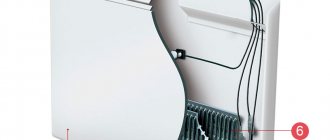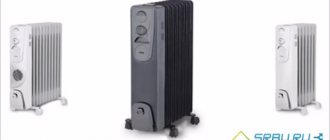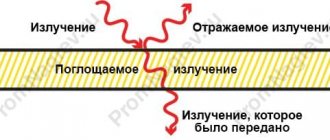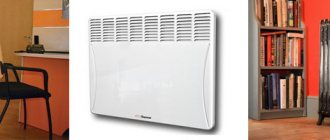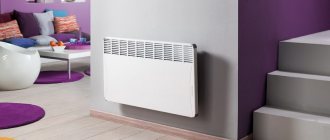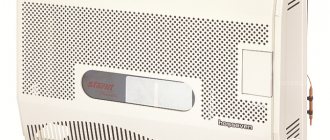Very often, with the onset of frost, apartments also become quite cool: the radiators do not burn at all, the central heating system cannot cope. The problem of heating a room is even more acute in private homes. As a rule, additional heating equipment from fan heaters to electric convectors comes to the rescue, with the latter type of heater gaining more and more popularity. Perhaps the convective-infrared heater deserves special attention for its technical characteristics and quality of work.
How does it work
Note!
The operating principle of the described device is based on the phenomenon of convection. From the physics course we know that cold air is heavier than warm air, it is located in the lower part of the room, the heated air masses gradually rise upward. Due to such movements, the entire air space in the room is heated.
The convector operates according to a simple algorithm. At the bottom of this device there is a heating element (it is also called a heat exchanger). To increase the volume of air passed through, this part is made in the form of a radiator with several flat fins. The angle of their inclination regulates the direction of heated air flows. The heat exchanger is covered by a protective metal casing.
According to the energy carrier used, all convectors can be divided into the following types:
- Devices powered by electricity;
- Gas convectors;
- Mermen.
Design of a convector heater
At the top, as well as at the bottom of the convector body, there are several holes for sucking in cold air and transporting heated air. Structurally, it is made in such a way that the body of our device does not have direct contact with the heat sink, so the casing does not heat up and does not transfer heat. A similar transfer of heat resources occurs in water and oil radiators.
In everyday life, electric type convectors are mainly used. Water appliances have lower efficiency indicators; they differ from analogues in their significant overall dimensions, so they are installed in places where traditional water radiators are installed in niches under windows. Gas equipment, despite the possibility of saving energy resources, for some reason is not popular among consumers.
Electric convectors
The mechanism of their action is similar to the principle of operation of a conventional central heating battery. In essence, you are purchasing another battery, but one that is more convenient and regulated. They heat the room with already heated air.
There are also gas convectors, but electric convection devices are safer and easier to use.
They are powered from an outlet, therefore, they cannot be used in open spaces (and this is unsafe). Unfortunately, when both types of convectors operate, there is a strong combustion of oxygen in the air. Therefore, it will not be possible to keep a convector-type device turned on for a long time, especially since the energy consumption during their operation is quite high.
How to choose for a dacha
When choosing the heating device in question for use in the country, you should pay attention to the following parameters:
- Safety of use of the device;
- Durability indicators;
- Price;
- Economical use of electricity or other coolants.
Convector heater in the interior of a room
When choosing between a wall-mounted and floor-mounted model, you need to take into account the fact of using the device. Many types of electric convectors are fixed to the wall surface, but if there is a need to move the heating device, it will be necessary to purchase additional equipment (wheels, protection against heating during accidental tipping).
The height of floor convectors does not exceed 20 centimeters, they are narrow and long. Wall-mounted models reach 50 centimeters in height. According to experts, devices that are located as close to the floor surface as possible have maximum efficiency, because heated air moves from top to bottom. In this regard, it is better not to buy wall-mounted equipment, or install such devices as close to the floor surface as possible.
When purchasing such devices, you need to pay special attention to the material and workmanship of the case, its overall dimensions, and design. Here you need to take into account the height of the body: the larger it is, the greater will be the air flow speed or the convector properties of the heater
Skirting convectors up to 20 centimeters in height heat the air well due to their significant dimensions; their length can reach up to 2.5 meters. A tall (up to 60 centimeters) heating device, in which the speed of air flow increases, will be more compact.
It is better to install the convector closer to the floor
Pros, cons
Pros:
- Long service life, multifunctionality.
- Minimal heat loss.
- Economical.
- Safety.
- Convenient design.
- Fast heating.
Convective IR device in the interior
Cons:
- Burns oxygen.
- Price.
When choosing a heater you need to consider:
- area to be heated;
- the amount you have.
Saving on electrical appliances is unlikely to lead to good results. The cheaper the device, the shorter its service life. The quality may be poor.
Convectors operating principle and features
The operating principle of KO is based on convection - air circulation. The air flow passes through the heating plates and raises the heat upward. The coolant, in our case air, most often circulates through a small pipe with a connected heating element. Infrared-convective heaters are powered in two ways:
electricity
Such devices have a closed loop of pipes through which air flows. The design of the device is made in such a way that air penetrates into all the cracks of the radiator as quickly as possible. Often a fan is installed in electrical appliances to speed up the heating of the room. Electric convectors replace conventional heating radiators and are easily installed on the wall. The latest generation models can be installed under the floor.
natural gas
Convector-type gas heaters use air from the street to burn gas, and they also send combustion products there.
Convectors powered by gas are considered a good option, since they do not depend on central supply networks, can be installed in any room and are much cheaper than their analogues. As always, there is one “but” - gas equipment requires the output of a coaxial pipe, which removes combustion products. To do this you will have to disturb the wall of the house. In addition, any “gas” work requires drawing up a project plan and its approval by the relevant services
. According to the law, the owner of the home, even if he wants, cannot install the equipment himself; for this, there are special authorities with a license for this type of activity. If the price of blue fuel in your region is low, then of all the options you should choose a gas convector.
Scope of use
The main feature of convectors is the ability to heat the entire room, and not just a specific area, such as a convector or an infrared-convective heater. The flow of hot air extends to the entire room, but the efficiency is still limited - the convector is afraid of drafts. If you have a large room, poor thermal insulation and frequent drafts, then this is not the best choice. Therefore, the optimal room is a small room with sufficient insulation, for example, insulated walls and high-quality windows.
Floor-standing
The Ballu BEP/EXT -1500 convector is designed for heating rooms with an area of 20 m2. This device operates on a 220-volt power supply and has several power switching modes, which allows you to achieve the optimal temperature for heating the room. The model is equipped with special wheels for easy movement around the room, there is protection against overheating and accidental tipping, there is a control panel and a timer. The price of the model is 4220 rubles.
The advantages of the model are: beautiful appearance, a 3-year warranty on the product, low power consumption. Cons: clicking noises are heard when the thermostat operates, an unpleasant smell when first heating up, the display is bright.
Ballu BEPEXT -1500 differs from the previous model in size and power
The Electrolux ECH/AG-1000MFR convector with a power of 1 kW is designed for heating small, including wet rooms with an area of 15 m2. The controls in this device are mechanical, it is possible to control the temperature, there is a dust filter, as well as protection against overheating. The heater has a moisture-proof housing, the price of the model is 2,450 rubles.
The advantages of Electrolux ECH/AG-1000MFR include: excellent functionality, fast heating of the room, small overall dimensions, absence of foreign odors during operation of the device. No deficiencies found.
Convector Electrolux ECH/AG-1000MFR
Thermor Evidence 2 Elec 1500 with a power of 1.5 kW is designed for heating rooms with an area of 15 m2. This model has electronic control, it is possible to adjust the temperature automatically. The device has a waterproof housing and protection against overheating and frost. The price of Thermor Evidence 2 Elec 1500 is 4,400 rubles.
The main advantages of this convector are: beautiful appearance, ease of use, quick heating of rooms, and can withstand significant voltage drops. The disadvantages include the high cost of additional equipment.
Thermor Evidence 2 Elec 1500
The Hyundai H-HV14-20-UI540 heater with two heating elements of 1.25 and 0.75 kW can operate in three modes. At maximum power, it is possible to heat rooms with an area of 24 m2. The device connects to a 220-volt household power supply, is equipped with a digital display, and has mechanical control. The device has built-in overheating protection, its price is 1,590 rubles.
Hyundai H-HV14-20-UI540
The advantages of the Hyundai H-HV14-20-UI540 include affordable cost, the ability to save energy by turning off the temperature relay when the room is intensively heated, fast heating, small dimensions and weight. Disadvantages: foreign odors when the device is first started, high body temperature, thermostat clicks.
https://youtube.com/watch?v=ToD4P-MjqxU%3F
Energy costs
To find out which is more economical - an infrared or convector device, you need to create the same conditions inside and outside the house. With hermetically sealed thermal insulation, the presence of interior doors and the same starting temperature indoors and outdoors, the IR emitter will consume less, since it only needs to spot heat the zones and then maintain the heat. In addition, it initially requires less power to reach a certain temperature. The convector must operate continuously. This explains the higher average price for IR heaters.
This comparison is correct only for insulated houses. In the case when you need to heat an open room or heating is carried out in severe frosts, an infrared fireplace will absorb approximately the same amount of energy as a convection fireplace.
Which is better - the main selection criteria
It is difficult to compare IR heaters and convectors, but it is still possible. It is worth considering the main criteria :
- efficiency - high-quality IR heaters consume 40-50% less energy than inexpensive convectors;
- comfort – IR heaters provide a higher level of comfort;
- efficiency - convectors provide heating of the entire room, IR heaters are used for local heating;
- design – convectors are more attractive, IR heaters are relevant for high-tech interiors;
- room heating speed – convectors heat the room more slowly.
The last drawback can be eliminated by remote heating control using smart plugs.
Comparison of features
The speed of air heating with convectors is very low, but they allow you to achieve the most uniform temperature distribution. You won’t be able to warm up in a cold room with a convection heater; you’ll have to wait several hours. The heat from the infrared emitter can be felt almost immediately, and there will be no accumulation of warm air near the ceiling. You can direct the beams directly to the area where a person is located.
Uniform heating of air using a convector is only possible in a closed room. In case of drafts, the device will not be able to warm up the room, because cold air will constantly fall in place of warm air. Infrared radiation heats objects, so even with a small draft it provides. There are projects for using infrared heaters even outdoors.
Ease of use depends on the configuration of the device. Wall-mounted convector models do not take up additional space and are easy to use. Free-standing devices may interfere with movement. Portable infrared heaters require a significant area for placement. To free up space, it is recommended to purchase hanging models that can be located on the walls or ceiling.
Unlike infrared heaters, convectors do not require monitoring of their operation. The device can be safely left turned on unattended. Infrared devices are characterized by a greater fire hazard, so it is recommended to use them with constant monitoring.
Do not direct the radiation of infrared devices at surfaces that may be damaged by elevated temperatures. Nearby furniture and interior items can become very hot.
The electrical safety of both types of devices is the same, but the infrared lamp heats up to high temperatures, therefore it is always protected by a special mesh from accidental touch, which can lead to burns. The infrared heater must not be covered or used for drying fabrics. Improper use may result in fire.
Infrared heaters are more environmentally friendly because they do not contribute to significant air movement inside the room. Convectors carry out constant circulation, as a result of which dust can rise into the air. But none of the devices of both types emit harmful substances during operation.
Convectors reduce humidity levels much more strongly, so they are recommended to be used in conjunction with humidifiers.
Both types of devices
are characterized by great durability
. Convectors have a reliable design that can operate without breakdowns for 10-15 years. High-quality infrared lamps can last up to 25 years or more.
Energy consumption depends on operating conditions. Research shows that infrared heaters are more economical than convectors. Savings in the use of infrared radiation are achieved due to the high heating rate. After reaching the desired temperature, the infrared heater can be turned off, but the heated objects will remain warm for a long time. And the convector often has to work continuously.
It is not possible to clearly determine which heating method is better. The choice always depends on specific tasks and operating conditions. A good solution would be to combine devices. You can purchase a combined heater or use two devices with different operating principles.
Which heater is more comfortable to use?
Electric convectors are presented in two model options, based on installation features. Wall-mounted models are attached to the wall at a height of 10–15 cm from the floor. Installation does not take much time. Once the device is mounted on the wall, it does not interfere with movement in the room and is not noticeable.
Floor-standing models are compact, equipped with wheels or stand legs. Due to its light weight and parameters, the device is easy to transport from one room to another. The presence of additional functions increases ease of use.
Infrared heaters are divided into mobile and stationary. Mobile models of infrared heaters can easily be moved within a room or transferred to another room. However, the body of an infrared heater often gets very hot, so you need to be careful when changing the orientation of the device or moving it to another room. Although the protective mesh protects from direct contact with the emitter, it has a fairly high temperature.
As for stationary infrared heaters, they are practically no different, in this regard, from convector heaters. They are installed on walls or ceilings and do not cause any inconvenience to the occupants of the room.
Convectors will be more comfortable to use. They do not require the same control as infrared devices. A convector can easily be left unattended, while a powerful infrared heater can emit a large amount of heat, which can lead to negative consequences for both a person and nearby surrounding objects. Both devices are silent. However, users note that some models of infrared heaters produce a cracking sound when heating and cooling, caused by thermal expansion of parts.
Overview of characteristics of infrared convectors power
If you want to choose, it is important to pay attention to the most important characteristic - power. This parameter is selected from the algorithm of 1 kW of device power for every 10 m2. If you plan to use the described unit as the main heat source, then it is advisable to choose a device with a power reserve to compensate for possible heat losses that escape through doors, windows and walls
If you plan to use the described unit as the main source of heat, then it is advisable to choose a device with a power reserve to compensate for possible heat losses that escape through doors, windows and walls.
There are models on the market with a power of 300 W. They can be used for temporary local heating of garages, basements and other utility rooms. For more efficient operation, it is best to place such devices closer to the person. An imported infrared convector is most often designed to be powered from a 240 V network, therefore, when connected to a standard network, the device will not operate at full power
You need to pay attention to this factor when purchasing. Heaters of this type can be electric or gas, the latter type is optimal for heating large areas, including terraces and verandas
Historical reference
Situations often arise when the installation of additional heating equipment is necessary. For example, when the heating system does not have enough power to heat the room, or it is cold winter outside.
Many people are trying to make homemade devices. Previously, simple fan heaters were used; in some houses, the devices were preserved, popularly referred to as “goats”.
With the onset of the 90s of the last century, electric convectors began to appear on the shelves. The production of these devices was carried out abroad, the equipment was expensive.
The devices were hung on the wall. The device is easy to operate and does not consume much electricity.
Convective, convective-infrared, and infrared designs have appeared on the market. The devices are even more economical, compact, and simple.
Choosing between an infrared heater and a convector
Quite often, modern consumers today do not know what to choose - an infrared heater or a convector. What is better, you can understand by reading the article. It is worth recognizing that both of these devices are popular for suburban real estate. Electric convectors have managed to prove themselves, having appeared on the market since the 90s. last century. They are easy to use and easy to follow.
Infrared heaters appeared only 5 years ago, today they are representatives of the latest generation. If you also cannot decide what to choose - a convector or an infrared heater, then you should pay attention to the fact that the first type of device heats the room due to the constant movement of air flows. They arise due to temperature differences in individual areas of the room.
In this case, one layer of air is heated after another, which ensures a relatively uniform temperature.
The disadvantage of such devices is the creation of a comfortable temperature only in a certain part of the room. Therefore, while looking for an answer to the question: “Infrared heater or convector - which is better?”, you will be able to make the right decision only when you become familiar with all the features of these devices. For example, infrared devices heat a room by emitting heat flows with a clear direction. That is why in a minimally short period of time, literally in 10 minutes, the area to which the rays spread will acquire a comfortable temperature. In this case, the energy costs will be insignificant, which is especially noticeable when compared with convectors.
Electric convectors quite often also benefit from the fact that they can fit into almost any interior. Most often, such units are installed in a wall niche or on special legs to make the device mobile
If you are thinking about the question of which is better - a convector or an infrared convector, then you should pay attention to the fact that the latter unit will work not only due to air flows, but also by heating objects. Among other things, infrared heaters can be installed even in the bathroom
If they are placed on the ceiling surface, the floors and tiles in the room will heat up. Experts advise choosing convectors if you want to install an autonomous heating system in your dacha.
Advantages and disadvantages
Having received solar advantages, the infrared heater has inherited stellar disadvantages. The radiation heats only those surfaces it is directed at. If an object is not in the zone of wave action, it will only be heated by the air, which in turn receives heat from the things around it - this is not a quick process.
The convector heats the air, which means the heat spreads quite quickly throughout the room and becomes more expensive with each square meter.
Due to the high efficiency of an infrared heater, energy consumption is lower compared to a convector. Many heaters are equipped with a temperature sensor that turns the device on and off automatically. If it is not there, reaching for the manual switch is not far.
Household models, except for the premium segment, operate in short- and medium-wave modes from 0.8 to 1.8 meters - outside this zone the cold sharpens its icy needles.
Long-wave emitters are equipped with remote controls and are mainly used in production, cafes, and public buildings - the heat spreads over a distance of 4 to 6 meters.
The heat emitter is not afraid of moisture and even direct contact with water, which cannot be said about a convector. Infrared heaters are used in greenhouses and greenhouses, and are often used in construction - for drying concrete, walls, and heating the soil. You can also take it to the open veranda or even to a picnic if you have a diesel generator.
It is cheap, consumes little energy and protects against drafts. If there is a breeze “walking” across the floor, but the apartment is warm from central heating, a glowing “hot water bottle” will become a temporary replacement for the “warm floor”. A space of several meters will quickly heat up, and walking around it will become pleasant.
A radiator convector can single-handedly replace a hot water battery and fill the room with heat evenly and quickly. Advanced versions with electronic filling control the temperature and turn on only when the thermometer starts to fall.
Some models have an anti-freeze mode that maintains the air temperature in the room at + 5 degrees Celsius. There are thousands of models on the market of different capacities and sizes, from huge to the smallest - baseboards, used for heating the space between windows.
Infrared heater
Infrared heaters have the largest number of varieties. The main classification is as follows:
- gas;
- quartz;
- carbon;
- halogen;
- micathermic.
The most common convectors in everyday life include carbon, halogen and quartz. The main working elements are the irradiation lamp and the reflector.
IR: how it works and where to use it
An IR heater creates radiation that heats surrounding objects.
The operating principle of IR heaters differs significantly from convection-type devices - here the surrounding objects are heated, not the air. Infrared devices can be compared to the effect of the sun - the rays penetrate the air and, reaching an object that does not transmit light, heat it. Such “rays” warm you regardless of the wind blowing or the surrounding environment. Likewise, IR devices are not afraid of drafts and work effectively even with poor thermal insulation.
. The convector heats the air: the flow of hot air rises, the cold air falls, and a lot of time passes until the room warms up. An IR heater heats nearby objects/walls/floors/people in a couple of minutes, but only locally – where the radiation passes. But it is worth remembering that IR heating, like the sun, “bakes” the side towards which the rays are directed. Therefore, in the question of which heater is better, convector or infrared, the optimal choice will be based on the place and situation of use.
The design includes an aluminum reflector and a heating element: halogen, tubular, ceramic or carbon. There is also a thermostat and a block for overheating or tipover.
Gas IR heaters
Infrared gas heaters are one of the most economical types of climate control equipment. Initially they were developed for heating country and country houses, but gradually began to be used for heating almost any domestic and industrial premises. They allow you not only to achieve significant savings, but also high-quality heating. The heat dissipation and performance of this type of device is excellent.
They are capable of running on natural or liquefied gas. Gas infrared heaters are small in size and lightweight. Thanks to this, they can be easily transported or rearranged from one place to another.
Dimensions
As a rule, models of electric convectors are quite compact in size and, when placed on the wall, take up minimal space.
They have a reduced depth; for some models the height can be 200 mm - for example, for NOBO convectors. In the photo: small electric convector; mobile and ceiling convectors
For infrared heater models, the dimensions depend on several factors - first of all, on the technical characteristics and purpose. Thus, mobile heaters designed for spot heating have fairly compact dimensions. Ceiling models, as a rule, are very long, however, given the location of their installation, such dimensions do not interfere at all, they only disrupt the aesthetic appearance of the room.
Infrared convector heaters
The IR convector combines the positive aspects of both types of heating equipment.
Electric infrared convectors are a new type of heating device that combines the functions of a convector and an infrared heater. The design includes a convector type heating plate and a front infrared emitting panel. The main feature is the creation of the so-called fireplace effect, when the device heats surrounding objects, and not the air in the room. Heaters of this type are designed for independent heating without additional devices. The functionality allows you to use a minimum of electricity to ensure optimal thermal conditions.
Wall-mounted infrared convector is the most common model with an attractive appearance. The latest models are made of black impact-resistant glass ceramics, which allows you to select devices to suit the modern style of the interior. A wide range of colors and sizes such as horizontal, vertical, narrow and even corner devices makes it possible to choose a device for any interior.
The only significant drawback is the high cost. The price for advanced models with high-precision automation starts at 60 thousand rubles.
The best heaters
Next we will describe several popular wall and floor models of convector heaters
We will pay special attention to their technical characteristics, advantages and disadvantages, which are taken from real consumer reviews
Wall mounted
The Ballu BEC/EZER-1500 heater with two-level power control and built-in display effectively warms a room up to 20 m2. Such a device has a turn-on timer and built-in tip-over protection. If necessary, the manufacturer can include in the delivery set special wheels for operating the convector on the floor.
Convector heater Ballu BEC/EZER-1500 with wheels included
The main advantages of Ballu BEC/EZER-1500 are silent operation, quick heating of the room, convenient control, and affordable cost. Disadvantages: clicks of the regulator, hard buttons, inability to warm up the room above 20 degrees Celsius. There are defects: incorrect assembly of the heating element. The price of the model is 2500 rubles.
The wall-mounted convector heater Stiebel Eltron CNS 150 S was highly appreciated by consumers. This device operates from a heating element with a power of 1.5 kW, its operation is controlled manually. There is a thermostat on the moisture-resistant case. The heater is equipped with protection against overheating and the influence of negative temperatures. Cost 6330 rubles
The main advantages of this convector include: silent operation, muffled clicks of the regulator relay, high speed of heating the room. No deficiencies found.
Stiebel Eltron CNS 150 S
Another model of the Timberk TEC.E3 M 2000 wall convector is designed for heating rooms with an area of 24 m2. This device operates from a 220-volt power supply; there is three-level power control by turning on several heating elements of 2, 1.15 and 0.85 watts. The convector has a moisture-proof housing and weighs 5.3 kilograms.
The advantages of Timberk TEC.E3 M 2000 are its affordable price of 2912 rubles, low electricity consumption, the ability to quickly warm up the room, and silent operation. Disadvantages: short cable, poor build quality, heater dries out the air.
Timberk TEC.E3 M 2000
Heater Ballu BEP/EXT -1000 with three-level power control. This small-sized device weighs only 5.8 kilograms and is protected against overheating and exposure to negative temperatures. The convector is designed for heating small rooms with an area of 15 m2. The cost of the unit is 3300 rubles.
The main advantages of Ballu BEP/EXT -1000 are: remote control of the device, small dimensions, functionality, quick heating of the room. Some buyers point out one drawback of this model - the creation of low temperatures in the room.
Ballu BEP/EXT -1000
Which heater is safer to use?
Electric convectors meet all fire safety requirements and are equipped with overheating protection. Thanks to the special protection of the heating element, the heating part does not touch the metal body, so there is no need for grounding. The surface of the convector does not overheat. Wall-mounted options are securely mounted on the wall, while floor-standing models are stable.
The heating element of an infrared heater has a high temperature, so its surface is covered with a partition or mesh - this protects against burns if accidentally touched. The models are equipped with overheating and fall protection functions. Radiation is safe for humans, but it is not worth abusing it and staying under its influence for a long time.
In terms of safety, the convector will be much more reliable. It does not have very hot elements and does not produce radiation. Infrared heaters, when used correctly, meet fire safety standards, but they are more fire hazardous devices. In addition, it should be mentioned that being under too intense infrared radiation for a long time is not very good for health. This can be compared to being under the scorching sun for a long time. Of course there will be no lethal outcome, but a headache can be guaranteed.
How to choose the right ICO
An infrared convective heater can be found in any specialty store or ordered online. Heater models are inexpensive. good quality is produced in Russia.
When choosing, you need to take into account the power of the converter heater: for large rooms or rooms with high ceilings, you need to choose a model with a large heat transfer area and a powerful heating element.
Adjusting the power will help lower or raise the temperature, depending on the comfortable climate in the room. Such heaters do not dry oxygen, so it is better to choose a powerful heater.
About 92% of the thermal energy emitted by infrared convectors is directed to the surfaces of objects falling into the radiation area. By the way, this includes not only objects, but also living organisms, such as humans. As for the air, it heats up only 8%. Radiation hits surfaces, objects, walls and floors, heating them. This is the principle by which primary heat is created. Heated objects begin to release accumulated heat to the air.
Which is better oil or convector
We have already described the principle of operation, advantages and disadvantages of convectors, and now we will get acquainted with the main technical characteristics of the oil radiator. Such devices are most often used to heat air in a private house, country house or city apartment. To get started, you need to connect the device to a power source and set the required temperature on the thermostat.
Oil radiator
This heater consists of a metal body made in the form of a radiator. Mineral oil is poured into the middle of the container, which heats up and transfers heat from the heating element. A rheostat is built into the device, which allows you to turn off the device when a certain temperature is reached.
The heater is equipped with protection against accidental tipping. In this case, the heating element turns off.
The advantages of oil radiators include:
- Silence;
- Low cost;
- The ability to move the device around the apartment to warm up the desired room.
When choosing a radiator heater in a store, pay special attention to the power of the device. In this case, 1 kW of consumed electricity is calculated for 10 m2 of usable area of the room
The power consumption range is from 1 to 2.5 kW. Some models have a switch-on timer, which allows you to warm up the room at the right time.
Variety of oil heaters
Now let’s take a look at the comparative characteristics of these two heaters:
- The first important nuance of choice is efficiency. Here it is necessary to give preference to convectors, because they consume 25% less electricity;
- The second parameter is the warm-up time. When turned on, the convector immediately heats the air, its efficiency can exceed 95%. For the second device, the heating element is first heated, then the oil, the metal body and finally the air in the room;
- The next important characteristic is ease of operation (movement). Convectors have small overall dimensions; they can not only be placed on the floor, but also hung on the wall. Oil radiators are massive, their weight can reach up to 25 kilograms, and they are not suitable for wall installation. The unit has wheels for more comfortable movement, and if you need to bring the unit to the 9th floor in a building with a non-working elevator;
- Operating period. According to the technical specifications, the convector can last at least 5 years, but in practice it turns out to be longer. High-quality oil radiators also have a huge service life, but cheap Chinese models can crack the metal, which leads to oil leaking from the body;
- And the last characteristic is the price of the device. Here the undisputed leader will be oil heaters.
Convector is a better option compared to oil radiator
Conclusion: When comparing these two heaters, it is recommended to give preference to convectors.
Design and principle of operation
Convectors and infrared emitters are fundamentally different in the heating method. To determine which device is more effective and expedient to use in specific conditions, it is necessary to study the structure and features of each type.
Everything you need to know when choosing a heater | Tips comfy.ua
The operating principle of the convector is based on air circulation in the room. The device consists of a housing and a heating element located inside. Typically the heater is installed on the floor. Cold air is heavier than heated air, so it is located at the bottom of the room. It enters through the air intake grille into the device, where it is heated, passing through the radiator of the heating element. masses, according to the laws of physics, rise upward. During the cooling process, the air descends and enters the heater again.
The device ensures constant air circulation in the room. The main difference between this type of device is the almost complete absence of direct heating of objects. The room creates a favorable atmosphere, which is quite comfortable to be in. However, this is not enough for difficult conditions.
Convectors are a good solution as an additional source of heating, and therefore are well suited for rooms in apartment buildings with centralized heating. If there is a need to warm up a cold room in a country house, the features of such devices will not allow creating the necessary microclimate. The feeling of warm air is deceptive. Cold walls and furnishings can cause colds.
Based on the type of heating element, convectors are divided into three groups:
Modern models can be additionally equipped with a temperature controller. Some of them allow you to set not only the heating power, but also the required air temperature. With the help of control modules, you can combine several devices into one group and, by working together, control the microclimate in the house.
As additional options, devices can be equipped with timers that set the duration of operation, remote controls, and air humidifiers.
Choosing a heater. Which is better? Advantages and disadvantages
Infrared radiation
The operation of an infrared heater can be compared to exposure to sunlight.
The device provides heating of walls and surrounding objects with infrared radiation. There is no direct transfer of heat to the air - it is heated by heated surfaces. This feature allows for effective local heating of certain areas in the room. Comfort is achieved at the very beginning of operation of the device, and there is no need to wait for the air in the room to completely warm up.
The main elements of the device are an infrared emitter and a reflector, which focuses and directs the rays in the desired direction. Emitters most often come in the following three types:
The reflector is made of polished steel or aluminum sheet. The bending radius of the reflector affects the dispersion of radiation and the heating area.
The heater is equipped with a safety device that turns off heating when the device falls or the set temperature is exceeded. This allows you to ensure fire safety during operation.
Recently, devices that combine both heating methods have begun to appear on the market. Such models are called infrared convectors. The front infrared emitting surface heats surrounding objects. Behind the front panel there is a cavity in which the air passing through the device is heated.
Infrared ones do a better job of heating than devices that use one heating method. The combination of different operating principles is optimal for quickly creating a comfortable indoor microclimate, however, combined devices are still extremely expensive, so in most cases it is cheaper to buy a convector and an infrared heater separately. Perhaps in the future the IR convector will become more accessible, which will lead to widespread use of devices of this type.
How to choose a heater. Which is the best electric convector?
Speed of reaching the desired temperature
Due to the peculiarities of its operation, the infrared heater provides faster spot heating of the air.
It can be focused on heating only the area where people are. At the same time, it will be effective for use in open spaces or those where there are drafts: gazebos, terraces, production workshops. A convection heater, in turn, provides more uniform heating of all the air in the room, but it takes more time to do this, since no additional tools, such as a fan, are used to pump warm air masses. Moreover, it will be most effective when working in enclosed spaces.
conclusions
As you can see for yourself, it is impossible to clearly decide which heater is better: infrared or convector. Both the first and second devices have a number of convincing advantages, and can fully reveal their potential in certain conditions. If we still compare, we would recommend using convector devices as an additional source of heat in enclosed spaces, and using infrared heaters if there is a need to create a local heated zone or heating in frequently ventilated rooms, as well as on verandas, gazebos, outdoor terraces. Well, it’s still up to you to choose what to buy!
Although a convector and an IR heater have the same purpose - to heat a room, they have completely different operating features and there is no point in comparing them. Let’s figure out in practice which infrared or converter heater should be chosen in this or that case.
